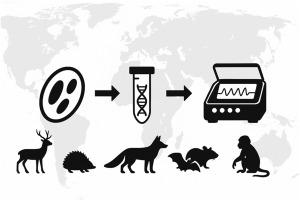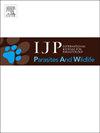野生哺乳动物作为立克次体宿主:基于分子证据的综述
IF 2.2
3区 医学
Q3 ECOLOGY
International Journal for Parasitology-Parasites and Wildlife
Pub Date : 2025-08-10
DOI:10.1016/j.ijppaw.2025.101128
引用次数: 0
摘要
立克次体是专性细胞内细菌,感染真核细胞。这些媒介主要由硬蜱和其他食血节肢动物传播,它们是若干物种的媒介和主要宿主。然而,在自然环境中,立克次体已经在野生和家养哺乳动物以及蜱虫中被发现。这篇综述全面讨论了全球范围内野生哺乳动物组织中立克次体的发生,并考虑了各大洲不同的宿主群体。立克次体DNA已在蝙蝠、有蹄类动物、食肉动物、啮齿动物和灵长类动物中检测到,从而强调了潜在宿主的广谱性。现有证据表明,其中一些可能在细菌的地方性循环中起作用。在欧洲,立克次体DNA在小型啮齿动物中显著流行,表明它们有可能成为天然宿主。在亚洲和非洲进行的研究已经在啮齿动物和食虫动物中发现了多种立克次体,强调了它们在人畜共患病传播中的作用。哺乳动物作为立克次体宿主的作用仍有待明确确定。本文章由计算机程序翻译,如有差异,请以英文原文为准。

Wild mammals as hosts of Rickettsia: a molecular evidence-based review
Rickettsia spp. are obligate intracellular bacteria that infect eukaryotic cells. These agents are transmitted primarily by hard ticks and other hematophagous arthropods, which are the vectors and primary reservoirs of several species. However, in the natural environment, Rickettsia spp. has been identified in wild and domestic mammals, as well as in ticks. This review comprehensively addresses the occurrence of rickettsiae in tissues of wild mammals on a global scale, considering different host groups across continents. Rickettsia DNA has been detected in bats, ungulates, carnivores, rodents and primates, thus underlining the broad spectrum of potential reservoirs. Extant evidence suggests that some may play role in endemic cycles of the bacteria. In Europe, a significant prevalence of Rickettsia DNA has been demonstrated in small rodents, indicating their potential as natural reservoir hosts. Research conducted in Asia and Africa has identified various Rickettsia species in rodents and insectivores, emphasizing their role in zoonotic transmission. The role of mammals as reservoirs of rickettsiae remains to be definitively established.
求助全文
通过发布文献求助,成功后即可免费获取论文全文。
去求助
来源期刊

International Journal for Parasitology-Parasites and Wildlife
Medicine-Infectious Diseases
CiteScore
3.80
自引率
5.60%
发文量
113
审稿时长
45 days
期刊介绍:
The International Journal for Parasitology: Parasites and Wildlife (IJP-PAW) publishes the results of original research on parasites of all wildlife, invertebrate and vertebrate. This includes free-ranging, wild populations, as well as captive wildlife, semi-domesticated species (e.g. reindeer) and farmed populations of recently domesticated or wild-captured species (e.g. cultured fishes). Articles on all aspects of wildlife parasitology are welcomed including taxonomy, biodiversity and distribution, ecology and epidemiology, population biology and host-parasite relationships. The impact of parasites on the health and conservation of wildlife is seen as an important area covered by the journal especially the potential role of environmental factors, for example climate. Also important to the journal is ''one health'' and the nature of interactions between wildlife, people and domestic animals, including disease emergence and zoonoses.
 求助内容:
求助内容: 应助结果提醒方式:
应助结果提醒方式:


